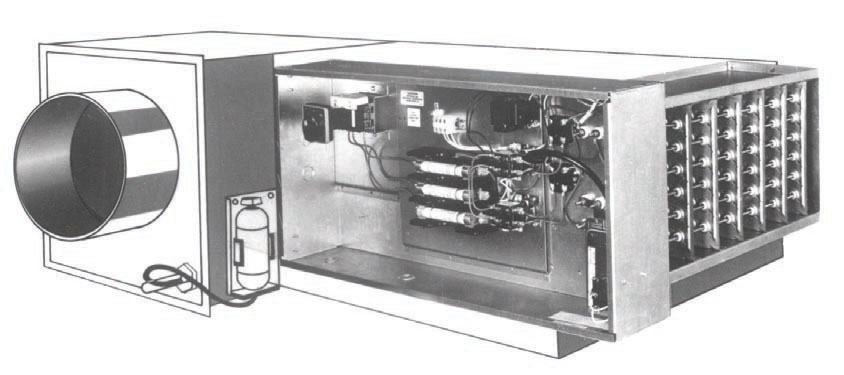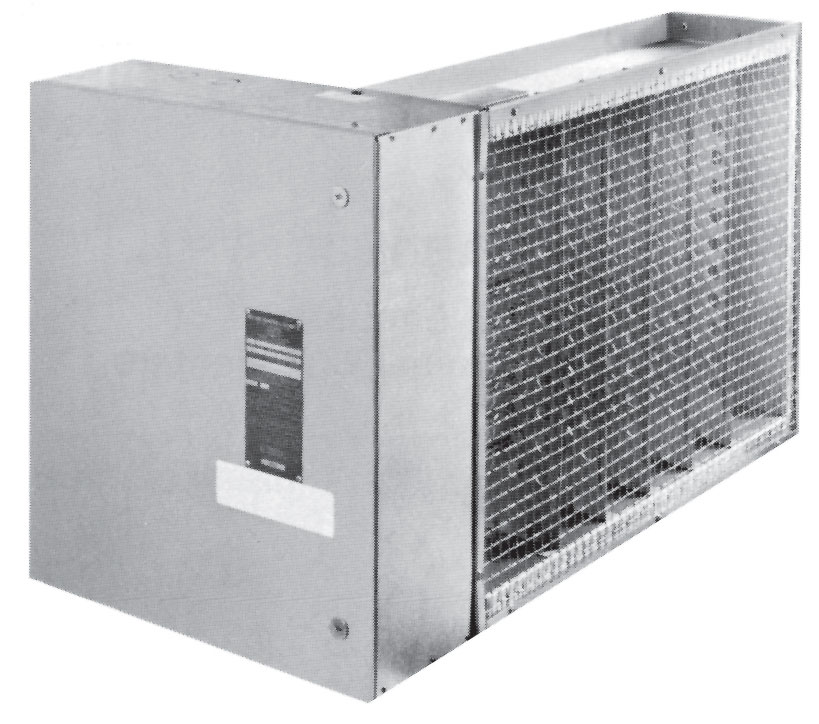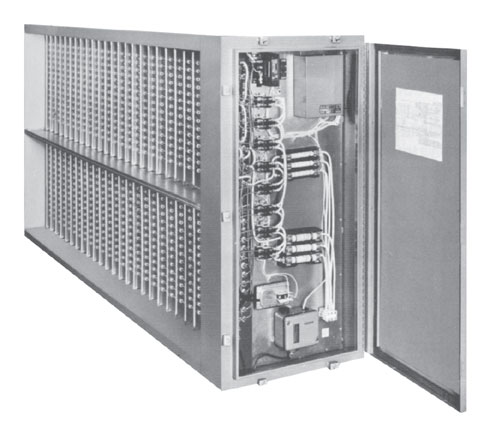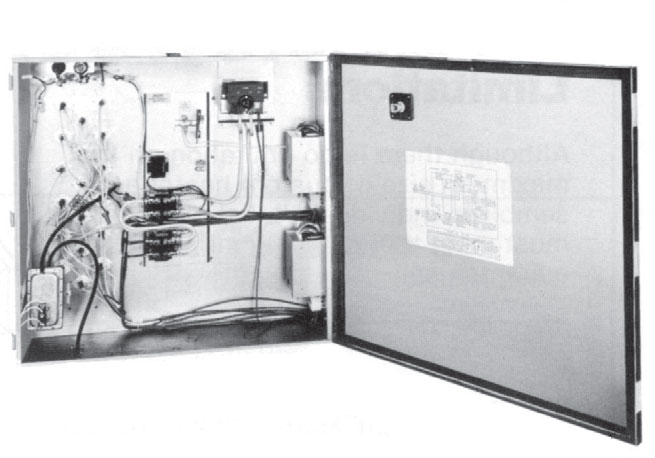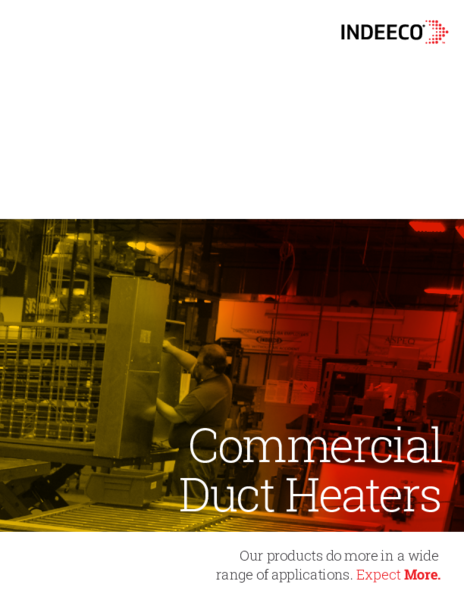Custom Duct Heaters
For more than five decades, Indeeco has been a trusted supplier of custom electric heaters designed specifically for use in air handling units and air conditioning equipment. Our extensive experience in this specialized field has led to the development of a wide range of proven construction techniques that ensure optimal performance, long-term reliability, and simplified installation—whether in the OEM’s facility or on-site in the field.
From compact units for rooftop HVAC systems to large-scale solutions for industrial air handling applications, Indeeco engineers heaters tailored to your system’s exact airflow, dimensional, and electrical requirements.
Approvals
Special Applications
Air Conditioning & Air Handling Units
For more than 55 years, Indeeco has been supplying special heaters for use in air handling and air conditioning equipment. A wide range of special construction techniques has been developed to insure proper operation as well as easy installation, either in the OEM’s plant or in the field. These heaters typically fall into one of the categories described on the following pages.
Modular Construction
The heater is designed to match adjacent air handling unit components, such as fans, cooling sections, filter boxes, etc. Special construction is used so that the heater mounts adjacent to other components; the heater becomes simply one module of the air handling unit assembly. Unheated sections are provided where there is little or no airflow, such as the area blocked by an adjacent cooling coil header. Pressure plates can be provided to insure uniform airflow, when the heater must be installed adjacent to the fan. Buffer sections can be furnished to space the heating coils away from temperature sensitive components or to help assure uniform airflow.
Round Duct Construction
Indeeco manufactures UL listed open coil duct heaters specifically designed for installation to commercially rated round ducts. Heaters are available for installation to spiral single and double wall or snaplock round sheet metal ducts with inside diameters of 6, 8, 10, 12, 14, 16, 18, 20, 22, 24, 26 and 28 inches. Two square to round male galvanized steel transitions, are supplied for field installation to the inlet and outlet of the duct heater. The transitions are attached directly to the flanges of the heater and to the round duct using sheet metal screws. The Indeeco transitions have been approved by UL to provide uniform airflow across the open coil elements to avoid hot spots, which could affect the performance of the heater.
Railway and Subway Applications
Tough rail car industry standards have been developed to overcome the severe vibration, shock, high operating voltages, and voltage swings routinely encountered. For more than 35 years, Indeeco has built heaters to meet these standards, using heavy gauge corrosion resistant steel frames and oversized coil and terminal support bushings.
Multi-Zone or Dual Duct Heaters
These heaters are designed for installation inside multi-zone or dual duct air conditioning equipment, where the airflow is highly variable and unevenly distributed. These heaters use coils derated to approximately 25 watts per square inch (3.8 watts per square cm) of wire surface area (approximately one half normal watt density). Low density coils run cooler, and thus, provide longer life under these stringent operating conditions.
These heaters are supplied with fully proportional SCR control or with many heating stages to insure that no more heat is being supplied than is absolutely necessary. Each heater stage is spread over the entire face area to take advantage of all available airflow.
A perforated pressure plate is factory-installed on the air inlet side of the heater to make the airflow as uniform as possible. Linear limit thermal cutouts protect against serious overheating anywhere along the length of the heater.
When the heater must be installed entirely within the unit, only thermal cutouts are built into the heater, a remote panel is required for controls. When the terminal box can be external, heaters are available with a wide range of built-in controls.
Marine Duty
Only Indeeco offers a UL Listed duct heater which is also ABS Approved and meets U.S. Coast Guard Requirements for shipboard use.
Variable Air Volume (VAV) Units
To serve the fast moving and very competitive VAV market, Indeeco has developed a fully computerized design and construction system, which enables us to ship substantial volumes of heaters in a wide variety of sizes, ratings, and control options quickly. This system was patterned after our methods of designing and producing standard duct heaters, modified to solve the problems unique to the VAV industry. Slipand- drive sheet metal connections, control packages tailored to VAV systems, and special techniques for fan interlocks are some of the features designed for this market.
Duct Heaters for Wet, Dusty and Corrosive Areas
Indeeco offers a wide selection of custom built electric duct heater designs for outdoor, wet, dusty, and corrosive areas. Typical applications include use with roof top air handling equipment, in washdown areas such as food processing plants, wet and humid spaces near indoor swimming pools, and marine or casino boat applications including shipboard use.
Features:
- Disconnect switch with door interlock
- Manual reset thermal cutout
- Automatic reset thermal cutout
- Stainless steel frame
- Large diameter stainless steel finned tubular heating elements
- Heavy duty control transformer
- Fusing per NEC
- Airflow switch
- Stainless steel terminal hardware
Outdoor UL Listed 3R
Outdoor type 3R heaters are intended for outdoor use to provide a degree of protection against falling rain, sleet, and external ice formation. UL Listed 3R heaters can be used in most HVAC outdoor applications and indoors for protection against dripping water. Water-tight hubs for incoming power and control connections are furnished.
NEMA 12 Type Terminal Box
For heavy duty industrial applications involving both dust and oil, NEMA 12 construction is available on custom heaters. The all welded, stainless steel terminal box has a hinged, gasketed cover with hold-down clamps. Scru-tite hubs for line and power connections are included.
Bottom Mounted Terminal Box
The NEC requires a work space at least 21/2′ (76.2 cm) wide by 3½’ (10.67 cm) deep in front of a heater terminal box for service access. More space is required for large heaters. When this space is not available at the side of a duct, the heater can be installed through the bottom, using a special bottom mounted terminal box construction, which maintains the required horizontal orientation of open coil resistance elements.
Custom heaters of either flanged or slip-in design are available with this feature. However, slip-in is normally preferred for ease of installation. UL Listed heaters are limited to the sizes indicated in Table XIII.
Pressure Plates
A 40% open pressure plate on the inlet side of open coil type heaters evens out the airflow pattern in installations where it is not uniform. A pressure plate significantly increases the pressure drop across the heater. This increase must be considered in sizing the fan motor. To assure correct plate location, specify the exact airflow direction.
Unheated Sections
Indeeco custom heaters can be supplied with unheated sections, either open or blocked off. Such constructions are particularly helpful when the heater frame must extend through an area with little or no airflow to maintain accessibility to the terminal box. For example, a heater next to a cooling coil should have extended terminal pins so no heat is generated adjacent to the cooling coil header. Most constructions are available with a UL label.
Slip-and-Drive Construction
This option for custom flanged heaters, allowing installation with conventional HVAC slip-and-drive connections, offers the rugged and secure mounting of a flanged heater, yet requires less installation labor than a slip-in heater. It is particularly useful when other equipment in the duct system uses slip-and-drive connections, as the contractor can standardize throughout.
By using Indeeco’s slip-and-drive construction in variable air volume (VAV) units, the manufacturer can offer the same standard VAV box for electric heat, hot water heat, or no heat.
Dust-tight Construction
A dust-tight terminal box is available to meet local codes that require dust-tight construction for a heater installed above a false ceiling when the entire area is used as a return air plenum. It is also suitable for commercial or light industrial applications and to avoid dust accumulation inside the terminal box while a building is under construction.
These boxes are spot welded corrosion resistant steel, with all openings sealed. The hinged cover is gasketed and hold-down clamps are provided. (Note that this construction does not meet the more rigid requirements of NEMA 12 described below).
NEMA 4 Type Terminal Box
For weatherproof locations and washdown areas, such as food processing plants, a NEMA 4 Type construction is available. This all welded stainless steel enclosure is furnished with a hinged, gasketed cover and is provided with water-tight hubs for incoming power and control connections.
Insulated Terminal Box
When the heater is installed in an air conditioning duct which runs through an un-airconditioned space, condensation may form inside the terminal box. To eliminate this condensation or for energy conservation, the back of the terminal box can be factory insulated. This construction is available with all heaters.
Protective Screens
Protective screens protect personnel from accidental contact with electrically hot open coil elements and prevent large airborne contamination from reaching the elements. The 3/8″ (9.5mm) wire mesh screen may be mounted on both sides of the heater. Finned tubular duct heater construction may be more appropriate for these applications.
Construction For Lined Ducts
All Indeeco slip-in heaters are suitable for use in ducts lined with up to 1″ (25.4 mm) of interior insulation. Extended terminals and the design of the thermal cutout system make standard slip-in heaters suitable for such installations without any deterioration in performance or life. Be sure that the duct dimensions specified are those inside the duct lining.
For slip-in heater applications where the insulation is more than 1″ (25.4 mm) thick or where flanged heaters are required. Dimensions inside the insulation must be specified as well as the insulation thickness.
Remote Panelboard
When specifying remote panelboards, we recommend the following changes in control and safety components to insure the safety of the installation and to minimize the field labor costs.
Contactors
Use disconnecting controlling contactors which break all ungrounded lines. Thus, when heat is not being called for, all terminals in the heater will be dead.
Pilot Switch
Add a dead front pilot switch to the heater terminal box to make it safe for servicing by simply tripping the pilot switch. This shuts off power to the heater circuits through the disconnecting contactors in the panel.
Fuses
Built-in fusing for each panelboard will be in accordance with UL and NEC requirements.
Except for SCR’s, which are mounted through the panelboard side wall, control components are mounted on a sub-panel. Labeled terminal blocks are provided for all field wiring, both in the panel and in the heater. Knockouts and wiring gutter spaces are supplied in all panelboards.
NEMA 1 panels are made from heavy gauge steel, welded and painted (as required), and are provided with a lock and key. Wall mounting, flush mounting, or floor mounting on legs are available.
NEMA 3R type panelboards for outdoor use are UL Listed. These are intended for outdoor use to provide protection against falling rain, sleet, and external ice formation.
NEMA 4 and NEMA 12 panelboards for outdoor, dusty, and oil atmospheres are also available, as well as explosion-proof panels furnished with cast aluminum enclosures.
All standard type QUA and QUZ heaters are available with remote panels. Panels for these standard heaters are available in NEMA 1 wall mounting only. Fusing, disconnecting contactors, and a heater-mounted pilot switch, all as described above, are supplied.
Minimum & Maximum Duct Dimensions
Although there is no limitation on the maximum size of custom heater assemblies, individual UL Listed heaters must meet the following minimum and maximum requirements (see tables below).
UL Listed custom heaters are also available in virtually any KW rating. However, heaters are restricted to maximum KW ratings based on the square feet of heated area.
Indeeco has built individual duct heaters for space heating applications ranging from 0.1 KW to over 900 KW, multi-section units with up to 2000 KW in one assembly, and face areas as large as 40′ wide x 14′ high. Exact dimensional and KW limits can be determined by contacting your local Indeeco representative.

